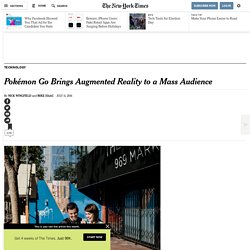

Cardboard – Google. Home. Best Augmented Reality Apps. Augmented Reality. Augmented Reality. Augmented Reality. Augmented Reality. Augmented reality. NASA X38 display showing video map overlays including runways and obstacles during flight test in 2000.

Augmented reality (AR) is a live direct or indirect view of a physical, real-world environment whose elements are augmented (or supplemented) by computer-generated sensory input such as sound, video, graphics or GPS data. It is related to a more general concept called mediated reality, in which a view of reality is modified (possibly even diminished rather than augmented) by a computer. The 20 Best Augmented-Reality Apps.
Augmented reality has long sounded like a wild futuristic concept, but the technology has actually been around for years.

It becomes more robust and seamless with each passing decade, providing an astonishing means of superimposing computer-generated images atop a user’s view of reality, thus creating a composite view rooted in both real and virtual worlds. Although AR apps run the gamut, from interactive map overlays and virtual showrooms to massive multiplayer skirmishes, each piece of software hones in on smartphone GPS and camera functionality to create a more immersive experience. The available selection of augmented reality apps is diverse, encompassing both premium and freemium offerings from a variety of big and no-name developers, but sometimes choosing which apps are worth your smartphone or tablet’s precious memory is tougher than using the apps themselves. Here are our top picks for the best augmented reality apps available, whether you’re searching for iOS or Android apps.
Augmented Reality. How Augmented Reality Works. Video games have been entertaining us for nearly 30 years, ever since Pong was introduced to arcades in the early 1970s.

Computer graphics have become much more sophisticated since then, and game graphics are pushing the barriers of photorealism. Now, researchers and engineers are pulling graphics out of your television screen or computer display and integrating them into real-world environments. What is augmented reality (AR)? - Definition from WhatIs.com. Augmented reality is the integration of digital information with the user's environment in real time.

Unlike virtual reality, which creates a totally artificial environment, augmented reality uses the existing environment and overlays new information on top of it. Boeing researcher Thomas Caudell coined the term augmented reality in 1990, to describe how the head-mounted displays that electricians used when assembling complicated wiring harnesses worked. One of the first commercial applications of AR technology was the yellow "first down" line that began appearing in televised football games sometime in 1998. Today, Google glass and heads-up displays in car windshields are perhaps the most well-known consumer AR products, but the technology is used in many industries including healthcare, public safety, gas and oil, tourism and marketing. Learn how augmented reality is being used by phlebotomists: Best Augmented Reality Apps. How Augmented Reality Works. The World Is Not Enough: Google and the Future of Augmented Reality - Alexis C. Madrigal.
What is augmented reality (AR)? - Definition from WhatIs.com. The next big thing in tech: Augmented reality - CNET. SANTA CLARA, Calif. -- Reality isn't what is used to be.

With increasingly powerful technologies, the human universe is being reimagined way beyond Google Glass' photo-tapping and info cards floating in space above your eye. The future is fashionable eyewear, contact lenses or even bionic eyes with immersive 3D displays, conjuring up a digital layer to "augment" reality, enabling entire new classes of applications and user experiences. Like most technologies that eventually reach a mass market, augmented reality, or AR, has been gestating in university labs, as well as small companies focused on gaming and vertical applications, for nearly half a century.
Emerging products like Google Glass and Oculus Rift's 3D virtual reality headset for immersive gaming are drawing attention to what could now be termed the "wearable revolution," but they barely scratch the surface of what's to come. Augmented Reality. Pokémon Go Brings Augmented Reality to a Mass Audience. Pokémon, a hybrid of the words “pocket” and “monsters,” belongs to the Pokémon Company, which is partly owned by Nintendo, the Japanese game pioneer, which has struggled to adapt to the era of gaming on mobile devices like smartphones and tablets.

In the cartoon, Pokémon trainers use characters to battle each other for sport. The uptake of Pokémon Go, which is so far available only in the United States, Australia and New Zealand, has been so furious that it sent Nintendo’s market capitalization soaring $9 billion in the last few days. Pokémon Go, though, is actually the work of a start-up, Niantic Inc., which was created inside Google and spun out of the company last year. Niantic’s first game, a science-fiction conspiracy thriller called Ingress, was made possible by Google’s digital mapping service. About 15 million users have downloaded Ingress, and there are a little over one million active players a month, said John Hanke, Niantic’s chief executive.
Augment: Enterprise Augmented Reality Platform. What is Augmented Reality? Webopedia Definition. Main » TERM » A » By Vangie Beal Abbreviated as AR, Augmented Reality is a type of virtual reality that aims to duplicate the world's environment in a computer.

Augmented Reality, Virtual Reality & Mobile Apps. Augmented reality. Augmented Reality - Home.